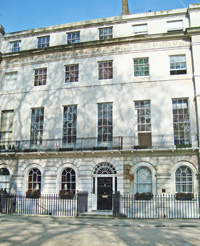Specialist
In 1897 the Oxygen Hospital (also known as the Oxygen Home) moved from 35, St George's Square, Pimlico, to No. 2 Fitzroy Square. It was officially opened by Princess Louise, Marchioness of Lorne (later Duchess of Argyll). The Hospital had been founded by Major George Stoker for "the treatment of ulcers and wounds by oxygen gas".
Mr. Stoker, a surgeon on the staff of the London Throat Hospital, had accompanied Lord Iveagh's Irish Hospital to South Africa during the Zulu Wars. While there he conceived the idea of a new surgical treatment. He had observed that Zulus suffering from gunshot wounds or burns were simply carried up the highest mountain in the neighbourhood, where they remained for a week or two. During this time their wounds were found to have healed. Stoker believed this to be due to the unusually pure air found at these altitudes. He began to experiment firstly with pure oxygen (found to be too rapid in its effects), then with a mixture of oxygen and air (ozone), which proved to be successful.
Discovered in 1840 by the German chemist Christian Frederick Schonbein at the University of Basel, Switzerland, ozone (O3) had first been used medically in 1856 to disinfect operating rooms and to sterilize surgical instruments. By the end of the 19th century ozone was used throughout Europe to disinfect drinking water supplies.
Treatment at the Hospital involved the affected limb being placed into a glass box, with the entry point sealed with rubber; the ozone was then pumped into the box. Cases of pulmonary tuberculosis (TB) and middle ear infections were also treated, the latter with an ozone spray (the ozone was passed through a Eustachian catheter into the middle ear for about 4 minutes, the treatment repeated daily if possible). It was recognised that patients with TB would not tolerate a face mask, so a tube was inserted up the nose and the ozone breathed in along with the room air.
Ozone was manufactured using an Androli's ozoniser - the oxygen passing from a cylinder through the ozoniser and, in doing so, coming into contact with a metal armature; this transformed the oxygen into ozone, presumed to be the air similar to that found at high altitudes.
It is not known when the Hospital closed (perhaps in 1911), but Mr. Stoker continued to provide oxygen treatments to soldiers wounded during WW1 at the Queen Alexandra's Military Hospital at Millbank.
The building was occupied by the Metropolitan Ear Nose and Throat Hospital in 1912.Present status (March 2009)
The Grade I listed building is now home to a bank - Grumpy Ltd.

Stoker G 1896 The economy of the treatment of wounds and ulcers by oxygen gas. British Medical Journal 1, 1087-1088.
Stoker G 1897 The Oxygen Treatment for Wounds, Ulcers, Burns, Scales, Lupus and Diseases of the Nose, Eye, and Ear. London, Bailliere, Tindall & Cox.
Stoker G 1899 Oxygen inhalations in the treatment of acute and chronic diseases of the lungs. British Medical Journal 1, 599-560.
Stoker G 1916 The surgical uses of ozone. Lancet II (Oct 21), 712.
Stoker G 1917 The surgical uses of ozone. Lancet I (May 26), 797.
http://en.wikipedia.org
http://hansard.millbanksystems.com
http://rcnarchive.rcn.org.uk (1897)
http://rcnarchive.rcn.org.uk (1902)
http://tripatlas.com
www.lumix.net
www.meridianinstitute.com
www.paperspast.natlib.govt.nz
www.wisegeek.com
www.zoominfo.com
Return to home page